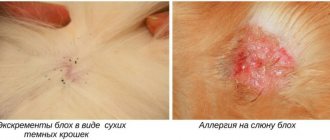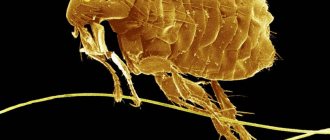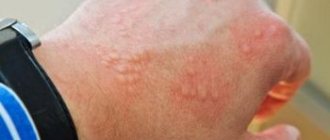The first signs of allergies
In a cat, a flea allergy can occur in different ways, depending on the individual characteristics of the body. Some animals react more acutely, while others have milder symptoms. This depends on the number of parasites, the state of immunity and the age of the pet. Kittens are the most susceptible to allergies.
Allergy to flea bites in cats has the following primary symptoms:
- Severe skin itching. The cat is constantly itching, trying to get to hard-to-reach places by biting the skin with its teeth.
- The appearance of alopecia in certain areas. Inflammatory lesions appear on damaged skin, affecting the hair follicles. This leads to active hair loss.
- Formation of bumps on the skin. Papules appear in the place where the flea bites were. They begin to become inflamed, causing discomfort.
- Change in skin color, appearance of pigment spots.
- Severe swelling of the skin.
Change in animal behavior
In addition to visual manifestations on the skin and hair loss, the psycho-emotional state of the animal changes. Due to severe, incessant itching due to an allergic reaction, the cat’s appetite decreases or completely disappears. The pet does not walk, becomes passive, spends most of its time lying down, scratching its skin.
Some cats, instead of passivity and apathy, on the contrary, may behave differently: their irritability increases, excessive aggressiveness occurs, which increases even more when the owner tries to touch damaged areas of the skin. The reaction to stroking the fur is a pitiful, prolonged meow.
Allergy to a flea collar in a cat, a case study
Greetings, friends!
Today I want to tell you about one interesting case: the cat you see in the photo developed an allergy to a flea collar. It would seem that the remedy that is supposed to protect the animal, on the contrary, did harm. Immediately after using the collar, no complications appeared, the animal behaved calmly, there was no itching, redness or hair loss. More than 10 days passed without any visible changes, then the cat had to be left alone in the apartment for a week, only other people came to feed it.
The onset of an allergy to the flea collar was not noticed, and when the owners returned, they found the same picture as you see in the photo below. It was not possible to find out exactly which company used the collar, but it was not cheap.
The hair on the neck has fallen out, changes are visible on the skin where the collar was
Friends, I am showing you a sick animal not to intimidate, but so that you understand that such complications can occur. If such symptoms occur, you need to remove the collar and then act depending on the changes that have occurred.
In most cases, no special treatment is required, just wait until the effect of the drug wears off. But if there are extensive skin lesions, changes in the animal’s behavior, severe itching, then you need to show the cat to a veterinarian.
Bald patch on a cat's neck
What to do, how then to fight parasites?
Let me make a reservation right away that even if you buy the best, most expensive collar, there may still be a negative reaction to it. You should always consider your animal's individual sensitivity, but there are some techniques you can use.
I have specially compiled a short list that will help you reduce the risk of allergies to flea collars and other antiparasitic agents. In addition to collars, we use drops, powders, sprays and other forms of preparations, but they operate on the same principle.
So, the list:
Place of purchase. It is important to purchase veterinary drugs in places that value their reputation at least a little: veterinary pharmacies, pet stores. Of course, you can buy a fake at a pharmacy, but the probability is much lower than at the market or near a bus stop.
Kind of animal. Sometimes they have a cat and a dog in the same house, so in order to save money they buy one anti-parasite collar for both of them. So, it's best not to do it unless you know exactly what you're doing. Some substances used for dogs can be dangerous for cats.
Dosage. Be sure to adhere to the dosage and route of administration of the drugs. A small digression on the topic. I have a video on my channel, I received a warning for it and many dislikes were placed under it. This happened because of my experiments with the title, and I called it: “How can you kill a dog. Five ways to kill a dog 18”, now it is called differently.
In order not to bore you with digressions, I simply recommend watching the video; there are no scenes of violence, murder or experiments on animals. In it I talk about how a person can foolishly harm his pet.
Age. I observe a frequent phenomenon when fleas multiply in large numbers in small kittens or puppies. It is clear that they need to be fought and people use various means in attempts to get rid of parasites. But children under a certain age cannot use most drugs.
In each case, for each drug, you need to carefully study the instructions to determine whether it is suitable for kittens or not. Here is an example of the incorrect use of flea drops, be careful.
Let's do a test. Any drug can cause a negative reaction in an animal, so you should always check individual sensitivity. How can I do that?
For example, you bought new drops against fleas, do not rush to use them right away, apply one drop to the skin and release the animal. Wait 15-20 minutes, if there is no negative reaction, then you can use the entire dose. I talked about how allergies manifest themselves here, if you are interested, come see them.
We do approximately the same thing: if the drug is in the form of a spray, apply it in one place and wait, then, if all is well, apply according to the instructions.
With collars it is a little more complicated; the allergy may not appear immediately, so you need to examine the animal daily, paying special attention to the skin in the neck area.
Emergency drug. I have spoken about this more than once, but it would not be superfluous to repeat it. You should always have one of the medications on hand that will quickly stop the allergic reaction. The drug is needed in injection form (injection) so that you can quickly use it. A dog or cat may lose consciousness, vomit, or have convulsions; in this case, the pill cannot be given.
I usually recommend using dexamethasone, it quickly copes with allergies, but keep in mind that it has many side effects - use it as a last resort.
Conclusion
Source: https://vetdoc.in.ua/allergiya-na-oshejnik-ot-blox-u-koshki-sluchaj-iz-praktiki.htm
Consequences of allergies
Severe itching of the skin, which occurs in response to flea saliva, causes the cat to actively itch and bite the skin with its teeth. This leads to mechanical damage to the epidermis and the appearance of open wounds. As a result, a favorable environment for secondary infection is created. Infection aggravates the course of the allergy and can lead to the formation of large inflammatory areas in which pus accumulates.
The resulting wounds contain pathogenic fungi and bacteria, which are not at all easy to deal with.
Allergies also have an extremely negative effect on the animal’s immune system. Suppressed immunity reduces the body's resistance to various viruses and infections. The cat's general condition and behavior are only getting worse.
In addition, allergies can trigger the development of Quincke's edema. This is a complex pathological condition that can lead to the death of an animal due to suffocation.
Why is itching dangerous?
After determining the factors that caused the skin irritation, the veterinarian will prescribe treatment. If itching accompanies any disease and it is detected, therapy should be started immediately to prevent the development of complications and infection of the person.
- Scabies, ringworm, and fungal infections (trichophytia, dermatomycosis) not only cause deforestation and cause severe anxiety to the cat, but can also be transmitted to humans.
- Ticks, lice, lice, and other external parasites, in addition to hair loss, can lead to secondary infections.
- Food allergies, reactions to plant pollen, medications and household chemicals can lead to Quincke's edema and the death of the cat.
- If an animal loses a lot of hair and experiences skin irritation due to psychological stress, it is necessary to take urgent measures to relieve the anxiety state. Otherwise, the cat loses weight, exhaustion and dystrophy occur, and it may die.
- If itching and hair loss occur for hormonal reasons, the cat often needs lifelong therapy to function normally.
- When a cat constantly scratches its ears, the skin inside and around the ear canals becomes covered with wounds and ulcers, and suppuration begins. An ear mite or bacterial infection must be treated to relieve your pet of pain, a condition that can lead to deafness or death as a result of brain inflammation.
When a cat runs, licks, scratches and is restless beyond measure, it may well be that this is how he reacts to the bite of some insect. You should carefully examine it, find and treat the wound.
Diagnosis of the appearance of dermatitis
The owner can independently determine the presence of fleas in a pet by changing behavior and examining its fur. But only a veterinarian can make an accurate diagnosis - an allergy to parasites - based on the results of laboratory tests and examination of the animal. To clarify the primary diagnosis, a sample is taken from the affected area of the skin and examined. In addition, an allergen test is prescribed.
Allergic dermatitis as a negative reaction to a large number of fleas has similar symptoms to a number of other diseases. Therefore, differential diagnosis is required. Allergy to parasites must be distinguished from diseases such as lice, sarcoptic mange, alopecia, and pemphigus foliaceus.
Dermatitis is a skin reaction that is a symptom and not a disease itself.
What to do first
Therapy for allergies to blood-sucking insects is complex. To begin with, it is important to quickly and completely remove fleas, and to stop signs of the pathological process and alleviate the pet’s condition, take medications.
Destruction of parasites
To remove parasites, it is recommended to use the following methods:
- The animal must be thoroughly washed with a special shampoo to kill fleas.
- Use a comb to comb the fur to remove parasite larvae.
- Apply a special product in the form of drops to the skin, which is aimed at killing fleas, ticks and other parasites.
- Give the cat an anti-worming tablet.
It is important to rinse off the foam very thoroughly; to do this, the wool is washed three times with clean water.
You cannot use a flea collar during therapy, as it can aggravate the pathological condition. This is due to the fact that the cat’s body reacts negatively to the chemical composition of the collar and the essential oils in its composition. This leads to cramps, nausea and severe, profuse vomiting, prolonged diarrhea and frequent fainting. Therefore, it is worn only as a preventive measure after the fleas have been destroyed with special means.
If necessary, all activities (bathing, combing, taking pills) are repeated. Although flea treatments for cats always give a positive result, if there are too many fleas, a repeat course may be required.
Home treatment
The house must be treated for fleas. They can jump from the animal's fur to pieces of furniture, remain on the carpet and then migrate back to the pet after it has been treated.
Treating your apartment for fleas is necessary to completely get rid of these insects.
For the home it is necessary to use special insecticides. You can buy them at a pet store. All upholstered furniture in the house, floor coverings, and carpets are subject to treatment. You also need to treat the floor, especially the baseboard. The cat mat on which the pet sleeps must be washed at high temperature.
If the animal lives in a private house and regularly goes out into the yard, the area needs to be thoroughly treated.
Can dogs be allergic to collars? How to deal with it?
13.07.2018
The spring-summer season is a real joy for every domestic dog, since warm days are another reason to go for a walk with the owner, where you can have fun playing on the grass or barking at other animals.
But for owners, this time is a source of a new portion of worries. For example, some owners notice that their dogs are allergic to the collar.
Is this possible? How to deal with it? Let's find out!
How does it manifest?
Like any other disease, dog allergy to collars manifests itself with typical symptoms. Under the collar, the skin first turns red, and then itching and hair loss begin. Also, weeping wounds and scratches may appear in this place and next to it.
Another manifestation is complex: the dog is sad, sleeps a lot and refuses to eat. Swelling may be observed in the muzzle area.
What do the symptoms say?
There are two typical reasons that can have similar consequences.
The collar is not fitted correctly
As we already said in one of our previous materials, long-haired dog breeds can have skin problems if the collar is not fitted correctly.
If it is wide enough and fits almost tightly to the neck, then due to the heat the collar may begin to chafe and the pet may itch. In appearance, the consequences of this are very similar to the symptoms described above, but, fortunately, they are not an allergy.
For treatment, a healing ointment and a new, more comfortable collar will be sufficient.
Allergy
Symptoms may indicate a real allergy. As in people, it can appear suddenly, even if nothing like this has been observed before.
Allergies rarely occur with simple collars, even the cheapest ones; flea and tick collars are another matter, which may well be the source.
They are a leather or, more often, rubber strip impregnated with a special chemical composition. The compositions may be different and act accordingly differently.
Some remain only on the fur, which, by the way, is quite ineffective, since, for example, fleas and ticks can exist quite calmly on the tail.
Others are absorbed through the skin and have a complex effect - the ingrained parasite, along with the blood, receives a dose of poison and dies.
It is precisely these chemical compositions, of which a whole series is used for impregnation, that can serve as causative agents of allergies, and sometimes (as in our last example) even cause poisoning.
It is also very interesting that natural oils, which are also sometimes used as “impregnation” of the collar, can also cause irritation and itching in high concentrations.
Separately, it is worth noting that the collar is not always the cause of the onset or exacerbation of the disease. There are often cases when owners themselves violate the instructions and combine the use of a collar with drops or sprays against parasites. As a result, excessive concentration of chemicals affects the health of the pet.
Although some collars indicate that they should be used after the parasites have been removed using drops, they should not be worn immediately after treatment. You need to wait 1-2 days.
What to do?
First of all, you should make a rule: monitor the behavior and condition of the dog during the first day of wearing a new collar. Moreover, this should be done even when you buy a model that you have already used.
At the first signs of an allergy - scratching, redness of the skin, watery eyes, coughing, sneezing, you should immediately remove the collar, without waiting for scratching and weeping wounds to appear. If the condition worsens, it is recommended to give the pet antihistamines to avoid swelling and reduce itching, as well as wash it with shampoo, thereby getting rid of the source of the allergy remaining on the fur.
If the allergy has started or it was not possible to immediately determine that it was caused not by food, but by the collar, you will have to select drugs to treat the wounds that have appeared. The collar, of course, should also be removed.
Important afterword
As you may have noticed, in the article we did not indicate a single name of the drug and did not offer a replacement for an unsuccessful purchase, which dog breeders love to ask on thematic forums.
The fact is that every dog, every organism is individual and what suits one dog may quite possibly cause an allergy in another.
Therefore, we highly recommend that you do not throw away the packaging of the collar until you are absolutely sure that it does not cause allergies in your dog.
Otherwise, you should immediately contact your veterinarian so that he can help you select medications for treatment and then suggest another product for parasites, based on the composition of the unsuitable product.
Source: https://24pet.ru/articles/can-there-be-an-allergy-in-dogs-to-the-collar/











